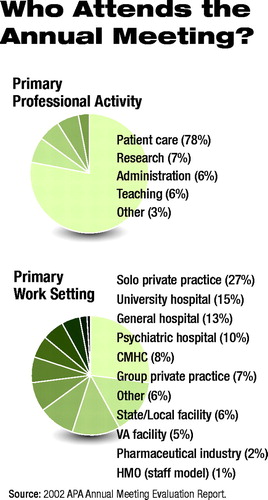Psychiatrists Give High Marks To 2002 Annual Meeting
Despite waning attendance at medical meetings worldwide since the September 11 terrorist attacks, APA still knows how to draw a crowd. The 2002 annual meeting in Philadelphia topped all attendance expectations, attracting a near-record number of attendees, according to an evaluation report on the meeting.
Kathleen Debenham, director of APA’s Department of Continuing Medical Education, prepared the report and presented it to the Scientific Program Committee at its July meeting in Washington, D.C.
“The Scientific Program Committee indicated that the data, particularly respondents’ comments and suggestions, were very helpful in framing their plans for the 2003 annual meeting,” said Debenham. That meeting will be held May 17 to 22 in San Francisco.
Attendance Breakdown
Of those who responded to the general evaluation survey, 97 percent “believed the quality of the annual meeting sessions to be excellent,” and 98 percent “felt that the sessions met their educational objectives.” In addition, 96 percent felt that the scientific symposia would help them practice psychiatry more effectively.
Total attendance at the meeting was 19,464, a figure surpassed only by that of the 2001 annual meeting in New Orleans (19,887). Of these, 27 percent, or 5,228, were exhibitors, staff, and media.
International attendance at the 2002 meeting was significantly lower than it was at last year’s meeting in New Orleans. While 4,279 international registrants participated in this year’s meeting, 2,000 more attended last year’s meeting. International attendance will be monitored over the next few years to determine whether the lower participation is a one-time phenomenon or a long-term trend.
In addition to Canada, which led the international contingent with 726 registrants, countries represented by more than 150 registrants included the United Kingdom (302), France (260), Mexico (202), Denmark (172), and Italy (168).
The turnout of media at the meeting pleased organizers—287 reporters and producers from approximately 115 media organizations registered in APA’s press office, including 23 from outside the United States.
Industry-Supported Symposia
APA utilized a variety of strategies to continue its monitoring of industry-supported symposia to ensure that the information presented in these sessions was balanced and unbiased.
Since 1998 APA has used the Resident Monitor Program for both the annual meeting and the Institute on Psychiatric Services, which is held in October each year (see Original article: page 25). Using guidelines developed by APA’s Committee on Commercial Support, psychiatry residents monitor the following: balance in each presentation, disclosure of conflict of interest by faculty, use of generic/brand names, disclosure of any discussion of unapproved or investigated uses, and any bias toward the supporting company’s products.
Presenters must follow the Accreditation Council for Continuing Medical Education and APA guidelines for commercial support, which include sanctions for noncompliance as approved by APA’s Board of Trustees.
The report concluded that APA’s symposia oversight measures were effective, since the majority of respondents agreed that “multiple viewpoints” and “an unbiased view of the topic” were presented in the sessions (94 percent). Ninety-eight percent agreed that the symposia met their educational objectives, and 96 percent of registrants also agreed that the ISS would help them improve the effectiveness of their practices.
The evaluation of the 2002 annual meeting was based on responses on the General Evaluation Form, which was included with registration materials, distributed on site, and mailed to registrants after the meeting. The evaluation survey could also be completed at nine computer terminals in the APA Resource Center and at kiosks in the Exhibit Hall.
 Of the 5,529 respondents to the general evaluation survey, almost 90 percent identified themselves as psychiatrists. Nonphysician health professionals made up only a small portion (4 percent) of the evaluation respondents. Additional details on attendees appear in the chart on page 11.
Of the 5,529 respondents to the general evaluation survey, almost 90 percent identified themselves as psychiatrists. Nonphysician health professionals made up only a small portion (4 percent) of the evaluation respondents. Additional details on attendees appear in the chart on page 11.
As part of the evaluation, meeting participants were asked what topics they would like to learn more about at future annual meetings. The participants expressed interest in more sessions on psychotherapy of all types, child psychiatry, mental retardation, and substance abuse, for instance.
Registrants were also asked to comment on how the meeting and facilities could be improved in the future. Some said that the “official” accommodations were too expensive or that they had a difficult time booking their hotel reservations, while others believed that the bus service could have been improved somewhat.
Due to the large number of attendees that led to overflow crowds at some sessions, a number of registrants suggested that larger meeting spaces be provided.
The majority of the registrants, however, responded positively on the evaluation forms. “The meeting was very well planned and organized,” wrote one respondent. “I enjoyed learning from all the great papers presented.”
Another wrote, “The APA [meeting] is always fun and educational. You get to meet your long-lost colleagues and learn new things at the same time.”
In addition, minority medical students who expressed interest in becoming psychiatrists and attended the meeting at the invitation of the APA/CMHS and APA/AstraZeneca fellowships were questioned about their reactions to the meeting. They too were impressed with what they experienced. One fourth-year student wrote, “Attending this meeting has definitely cemented my ambition to become a child psychiatrist. I even got a chance to meet and talk with [APA President] Dr. Richard Harding—a discussion I will never forget.”
Another fourth-year student commented, “I thought the sessions on minority mental health needs and on networking among minority physicians, residents, and fellows were extremely helpful. . . . I began to see places where I could contribute via research and through service on one of the APA committees.”
A third-year student said, “Having attended the annual meeting, I am one step closer to finalizing my career choice in psychiatry.”



